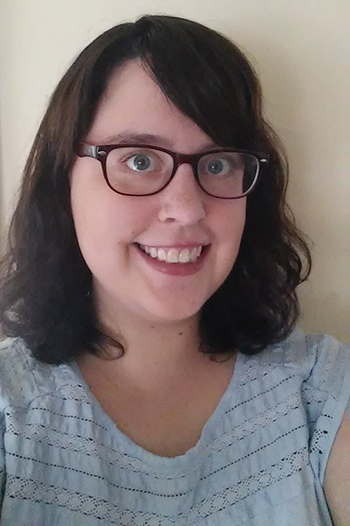
Kadie Seitz
USC Shoah Foundation began digitizing Holocaust testimony collections from Holocaust museums across North America last year as part of its Preserving the Legacy initiative. Ever since then, special staff members like Kadie Seitz have been hard at work indexing those thousands of testimonies in preparation for their integration into the Visual History Archive.
Collections from Holocaust museums in Montreal, Toronto, San Francisco and Houston have already been digitized and are now being indexed by about a dozen staff who learned how to index (assign keywords to each minute of testimony) at intensive training sessions with staff including archive curator Crispin Brooks and consultant Ita Gordon at USC Shoah Foundation in Los Angeles. Now, they are working from home (in the United States and Canada) using USC Shoah Foundation’s indexing software. Each indexer completes a few testimonies per week.
Seitz comes from both a history and library background, with master’s degrees in library and information studies as well as history from the University of Wisconsin-Milwaukee. She has also studied the Holocaust and worked as a teaching assistant for undergraduate Holocaust courses.
She said being an indexer is an ideal intersection between her history and library backgrounds, since it draws on her historical knowledge of the Holocaust as well as her study of how how information and archives can be organized to provide the best access to researchers.
“It also appealed to me because of the work of the USC Shoah Foundation, which continues to push the boundaries of both historical preservation and information access in a really fascinating way,” Seitz said.
Seitz has mostly been indexing Hungarian, Czechoslovakian and a few Polish testimonies from the Canadian and San Francisco collections. One of her biggest challenges has been figuring out the correct spelling of names and places interviewees mention in their testimonies. Luckily, there are several resources available to help her, she said.
Watching and indexing the testimonies, many of which have never been viewed since they were initially recorded decades ago, and knowing that she is helping to make them available to the public is very rewarding, Seitz said.
The most memorable testimonies for her are the ones that demonstrate how normal the lives of survivors were before the events of the Holocaust and World War II.
“Survivors had many of the same struggles or experiences that we do, except that they were thrust (often unwillingly) into such a terrible situation,” Seitz said. “These testimonies can help to reveal the true horrors of genocide.”